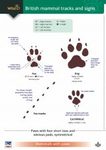World / Checklist Flora / Fauna
Out of Print
By: AJT Johnsingh(Editor), Nima Manjrekar(Editor), George B Schaller(Foreword By), Maya Ramaswamy(Illustrator)
799 pages, 60 plates with colour photos; b/w photos, b/w distribution maps, tables
![Mammals of South Asia, Volume 2 Mammals of South Asia, Volume 2]()
Click to have a closer look
About this book
Contents
Related titles
About this book
The second half of this encyclopedic work on the mammals of South Asia, with the remaining 34 chapters, covering the orders Cetacea, Proboscidea, Perissodactyla, Artiodactyla, and Rodentia, as well as a checklist of the mammals of South Asia.
Contents
Preface and Acknowledgements xvii
Foreword by George B Schaller xxix
Introduction xxxiii
(Order: Cetacea, Sirenia}
35. Marine mammals 1
(Order: Cetacea)
36. Ganges river dolphin 42
(Order: Proboscidea)
37. Asian elephant 71
(Order: Perissodactyla)
(Family: Rhinuceroridae)
38. Greater one-horned rhinoceros 95
(Family: Equidae)
39. Wild asses 112
(Order: Artiodactyla)
(Family: Suidae)
40. Pygmy hog 129
(Family: Tragulidae)
41. The chevrotains 146
(Family: Moschidae)
42. Musk deer 159
(Family: Cervidae)
43. Muntjac or barking deer 176
44. Chiral 192
45. Sambar 223
46. Barasingha (Indian swamp deer) 242
47. Eld’s deer 258
48. Hog deer 272
(Family: Bovidae)
49. Gaur 287
50. Nilgai 300
51. Chousingha or four-horned antelope 312
52. Blackbuck 322
53. Chinkara or Indian gazelle 341
54. Serow 352
55. Goral 362
56. Takin 376
57. Himalayan tahr 385
58. Nilgiri tahr 409
59. Himalayan ibex 433
60. Bhatal 450
61. Other wild goats and sheep 463
(Order: Rodentia)
(Family: Sciuridae)
62. Indian giant squirrel 483
63. Grizzled giant squirrel 501
64. Sciurids 513
(Family: Mutidae)
65. South Asian muroids 574
(Family: Hystricidae)
66. Indian crested porcupine 643
67. Little-known mammals 653
68. Diseases and parasites of wild mammals 694
69. Checklist of mammals of South Asia 720
List of contributors lxv
Species index lxxi
Customer Reviews
World / Checklist Flora / Fauna
Out of Print
By: AJT Johnsingh(Editor), Nima Manjrekar(Editor), George B Schaller(Foreword By), Maya Ramaswamy(Illustrator)
799 pages, 60 plates with colour photos; b/w photos, b/w distribution maps, tables
"A milestone In the natural history of the subcontinent, an indispensable, detailed source of information and of value to everyone interested in mammals, whether layperson or scientist. With rigour and objectivity, the two volumes cover all 590 species in the region, many of them in detail and depth based on consummate research conducted during the past half-century. This reflects a genuine increase in knowledge since the 1960s when many species – from slender loris to elephant were, for the first time, studied in the wild by trained biologists, with patience and respect, to create intimate and enduring portraits of other beings."
- George B. Schaller in the foreword






















![How to Find and Identify Mammals [Revised Edition]](http://mediacdn.nhbs.com/jackets/jackets_resizer_medium/21/210208.jpg?height=150&width=106)









